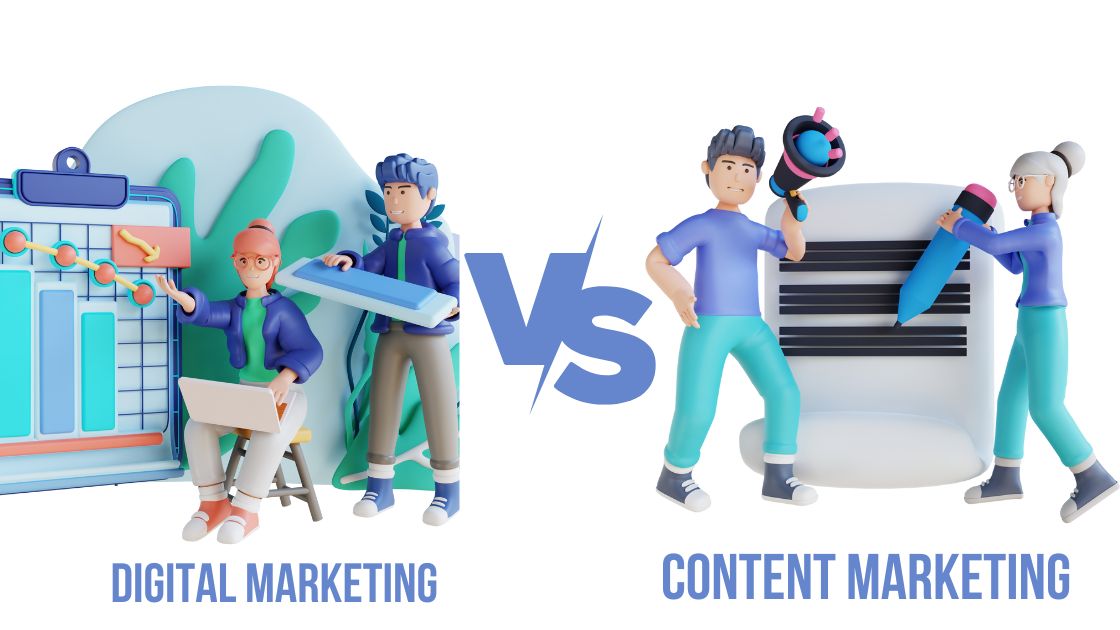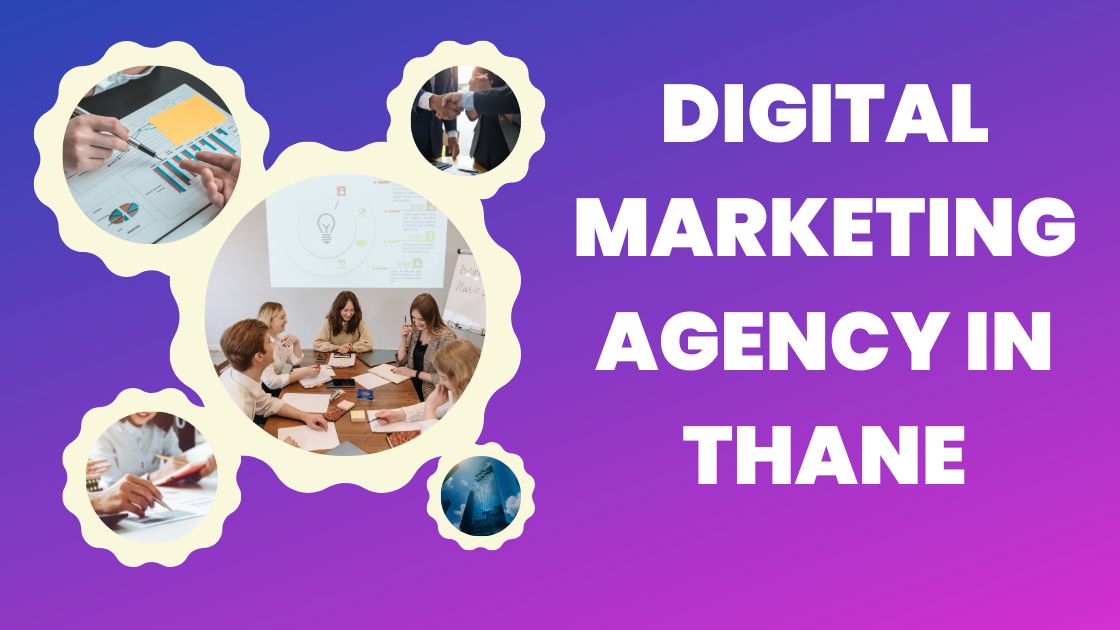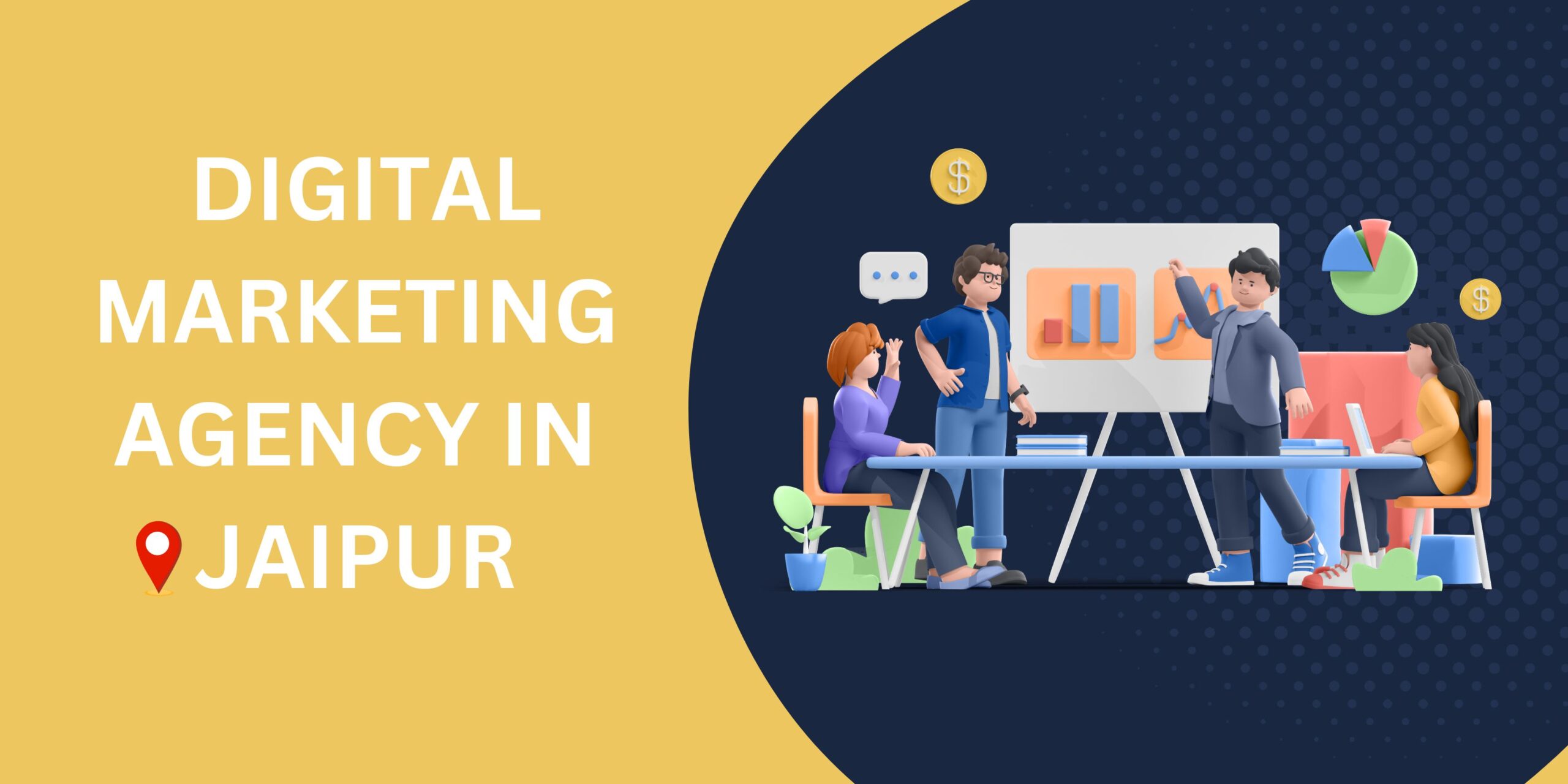Introduction:
In today’s fast-paced digital landscape, businesses must navigate the ever-evolving realm of online marketing strategies to stay ahead of the competition. Two prominent players in this arena are digital marketing and content marketing. While these terms are often used interchangeably, they represent distinct approaches that serve different purposes. In this blog, we will delve into the Digital Marketing VS Content Marketing and , exploring their differences, similarities, and the ways in which they can work together to drive remarkable results.
Table of Contents
What is Digital Marketing
In today’s digital age, companies have realised the significance of using the internet to reach their customers. Promoting goods and services, as well as companies and their brands, through digital means is known as “digital marketing.” Search engine optimisation (SEO), pay-per-click (PPC) advertising, social media marketing, email campaigns, content marketing, and other methods are all included.
With digital marketing, companies may interact with a large number of potential customers online, increase sales, and expand their customer base. It enables real-time monitoring of campaign success alongside pinpoint targeting and personalized messages. Digital marketing is a strategy that uses the internet and related technologies to raise awareness of a brand, attract potential customers, grow an existing customer base, and accomplish other commercial objectives.
What is Content Marketing
Within the larger umbrella of digital marketing, the content marketing strategy may be broken down into its component parts. It centres on the process of developing and delivering information that is valuable, relevant, and engaging with the goal of attracting and retaining a target audience that has been explicitly identified. Instead of blatantly promoting items or services, the major goal of content marketing is to create trust with potential customers by providing value first and then working to earn their confidence.
The practice of content marketing requires the production of material in a variety of media, including but not limited to blog posts, articles, videos, infographics, and podcasts. The material has been crafted to specifically address the requirements, interests, and problems faced by the audience that is being targeted. Businesses strive to position themselves as reliable authority in their fields by publishing material that is of high quality, instructive, and amusing. In doing so, they want to foster long-term connections with their customers.
Digital Marketing VS Content Marketing
Digital Marketing and Content Marketing may seem intertwined, but their differences lie in their core objectives and approaches. Digital Marketing is primarily concerned with promotion and visibility, leveraging various digital channels to reach a wide audience and drive conversions. Content Marketing, on the other hand, places emphasis on creating valuable content to attract and engage a specific target audience, with the ultimate goal of building trust and establishing long-term relationships.
Key Differences:
Objectives:
Digital Marketing: The primary objective of digital marketing is to promote products, services, or brands using digital channels. It focuses on generating leads, increasing sales, and driving conversions. The main goal is to increase visibility, reach a wide audience, and achieve measurable results.
Content Marketing: Content marketing aims to create and distribute valuable and relevant content to attract and engage a specific target audience. The main objective is to build brand awareness, establish thought leadership, and cultivate long-term relationships with customers. Content marketing focuses on providing informative, entertaining, or educational content to gain trust and loyalty from the audience.
Approach:
Digital Marketing: Digital marketing relies on various online channels and techniques, such as search engine optimization (SEO), search engine marketing (SEM), social media marketing, email marketing, display advertising, and more. It utilizes data-driven strategies, targeting specific demographics or user behaviors to optimize campaigns and drive immediate actions, such as making a purchase or filling out a form.
Content Marketing: Content marketing revolves around creating high-quality and valuable content, such as blog posts, articles, videos, infographics, podcasts, or e-books. The focus is on providing valuable information, addressing customer pain points, and solving their problems. Content marketing takes a more long-term and holistic approach, aiming to establish credibility, trust, and authority within a specific industry or niche.
Audience and Engagement:
Digital Marketing: Digital marketing often targets a broader audience or specific segments based on demographics, interests, or behaviors. It aims to capture attention and encourage immediate actions, such as clicking on ads, subscribing to newsletters, or making a purchase. While engagement can occur, the primary focus is on driving conversions and achieving specific performance metrics.
Content Marketing: Content marketing aims to engage a specific target audience that shares a common interest or need. It focuses on creating content that resonates with the audience, sparks their interest, and encourages interaction. The goal is to build a loyal community of followers who actively consume and share the content, participate in discussions, and ultimately become brand advocates.
Emphasis on Sales vs. Relationship Building:
Digital Marketing: Digital marketing strategies often prioritize sales and revenue generation. The focus is on driving immediate actions, such as making a purchase, signing up for a service, or filling out a lead form. The goal is to convert leads into customers and maximize sales through targeted advertising and optimized conversion funnels.
Content Marketing: Content marketing takes a more relationship-focused approach. The emphasis is on providing valuable and informative content that resonates with the target audience. By delivering relevant content consistently, brands aim to build trust, credibility, and authority. The goal is to establish long-term relationships with customers, cultivate brand loyalty, and generate repeat business.
Content Creation and Distribution:
Digital Marketing: Digital marketing involves creating various types of content, such as ad copy, landing pages, email campaigns, and social media posts, with a primary focus on driving conversions. The content is often concise, persuasive, and optimized for specific digital platforms. Distribution channels include paid advertising, social media ads, search engine marketing, and email marketing.
Content Marketing: Content marketing places a strong emphasis on creating valuable, relevant, and in-depth content that addresses specific audience needs or pain points. Content can take the form of blog articles, how-to guides, videos, podcasts, or interactive experiences. The content is typically distributed through owned channels like a company blog, social media profiles, email newsletters, or content hubs.
Metrics and Measurement:
Digital Marketing: Digital marketing relies on various metrics and key performance indicators (KPIs) to measure success. Metrics include click-through rates (CTR), conversion rates, cost per acquisition (CPA), return on ad spend (ROAS), and other performance indicators. The focus is on quantifiable results, measuring the effectiveness of campaigns, and optimizing strategies based on data.
Content Marketing: Content marketing often uses different metrics to assess its impact and success. Metrics can include website traffic, time spent on page, social media engagement (likes, shares, comments), email open rates, and conversions attributed to content consumption. While some metrics can be quantifiable, content marketing also values qualitative indicators such as brand sentiment, thought leadership recognition, and audience feedback.
Scope and Flexibility:
Digital Marketing: Digital marketing encompasses a wide range of tactics and channels, including search engine marketing, social media marketing, email marketing, display advertising, influencer marketing, and more. It allows for a high degree of flexibility in terms of targeting specific audiences, adjusting campaigns in real-time, and optimizing for better performance based on data and analytics.
Content Marketing: Content marketing is primarily focused on creating and distributing valuable content. While digital channels are often used to distribute content, content marketing itself is not limited to specific platforms. It can include offline materials, such as printed magazines, brochures, or educational resources. Content marketing allows brands to showcase their expertise and provide value to their audience regardless of the distribution medium.
Timing and Longevity:
Digital Marketing: Digital marketing campaigns often have a shorter lifespan and are more geared towards immediate results. Ad campaigns may run for a specific period, targeting time-sensitive offers or events. Digital marketing strategies require continuous monitoring, optimization, and adaptation to stay relevant in a fast-paced digital landscape.
Content Marketing: Content marketing takes a more long-term approach. The content created for content marketing efforts is often evergreen, providing value over an extended period. It focuses on building a library of resources that can continue to attract and engage audiences for months or even years. Content marketing strategies prioritize consistency and quality over immediate time-bound campaigns.
Paid vs. Organic Reach:
Digital Marketing: Digital marketing often relies on paid advertising to reach a wider audience. It involves allocating budgets for paid search ads, display ads, social media ads, or sponsored content. While this provides targeted visibility and immediate results, it requires ongoing investment to sustain visibility and reach beyond organic channels.
Content Marketing: Content marketing primarily relies on organic reach and engagement. By creating valuable and shareable content, brands aim to attract an audience organically through search engine rankings, social media sharing, word-of-mouth, and backlinks from other websites. While content marketing can be amplified through paid promotion, the emphasis is on building organic reach and brand advocates.
Focus on Branding and Authority:
Digital Marketing: Digital marketing strategies often focus on immediate promotional messaging and call-to-actions. While brand awareness can be a byproduct of digital marketing efforts, the primary objective is often to drive conversions. Digital marketing may prioritize short-term gains over building long-term brand authority.
Content Marketing: Content marketing places a significant emphasis on branding and thought leadership. By consistently providing valuable content, brands can establish themselves as industry leaders and experts in their field. Content marketing aims to build trust, credibility, and a positive brand perception among the target audience, contributing to long-term growth and customer loyalty.
Cost and Resource Allocation:
Digital Marketing: Digital marketing often requires a budget allocation for paid advertising, software tools, and resources needed to manage campaigns effectively. It involves ongoing optimization and monitoring, which may require dedicated personnel or the involvement of a digital marketing agency. The costs can vary depending on the competitiveness of the industry, target audience, and desired reach.
Content Marketing: Content marketing can be more cost-effective compared to digital marketing, especially when considering organic reach. While there may be expenses related to content creation, such as hiring content creators, graphic designers, or video producers, the distribution of content through owned channels like a company blog or social media profiles often has lower costs. Content marketing often requires a consistent investment of time and resources to produce high-quality content.
Buyer’s Journey:
Digital Marketing: Digital marketing strategies often align with different stages of the buyer’s journey, from awareness to consideration and decision-making. It aims to capture the attention of potential customers and guide them through the sales funnel. The focus is on creating targeted messages, utilizing remarketing tactics, and optimizing landing pages or sales funnels to convert leads into customers.
Content Marketing: Content marketing takes a broader approach and caters to the entire buyer’s journey. It focuses on creating content that addresses the pain points and needs of potential customers at each stage of their journey. Content is created to educate, inform, and provide solutions, building trust and nurturing leads over time. Content marketing aims to be a valuable resource throughout the customer’s decision-making process.
Control over Messaging:
Digital Marketing: Digital marketing campaigns often have more control over the messaging, as they can be tailored to specific goals or calls-to-action. Messaging in digital marketing can be optimized for conversions, using persuasive language, urgency, and offers. However, this can sometimes come at the expense of building a deeper connection or providing in-depth information.
Content Marketing: Content marketing allows for more in-depth storytelling and the ability to provide valuable information to the audience. The messaging in content marketing is often focused on building trust, authority, and thought leadership. Content marketing allows for a more nuanced and educational approach, fostering a deeper connection with the target audience.
Adaptability and Evolving Trends:
Digital Marketing: Digital marketing strategies need to stay agile and adapt to the rapidly evolving digital landscape. It requires staying up-to-date with the latest trends, changes in algorithms, and emerging platforms or technologies. Digital marketers need to be flexible and quick to respond to shifts in consumer behavior and adjust their strategies accordingly.
Content Marketing: Content marketing is also subject to changes in consumer behavior and emerging trends. However, content marketing often focuses on creating evergreen content that remains relevant over time. While the distribution channels and formats may evolve, the core principles of providing valuable and insightful content remain constant.
Measurement and ROI:
Digital Marketing: Digital marketing campaigns often have more measurable and immediate metrics to track. Key performance indicators (KPIs) such as click-through rates, conversion rates, cost per conversion, and return on ad spend provide quantitative data to evaluate campaign success. The focus is on generating a positive return on investment (ROI) and optimizing campaigns based on data-driven insights.
Content Marketing: Measuring the impact and ROI of content marketing can be more challenging as it focuses on long-term goals such as brand awareness, engagement, and customer loyalty. Metrics like website traffic, engagement rates, social media shares, and lead generation attributed to content consumption can provide some insights. However, the true value of content marketing often lies in its cumulative impact and the long-term relationships it fosters, which may not be easily quantifiable.
Advertising vs. Owned Media:
Digital Marketing: Digital marketing often relies on advertising through external platforms or media channels. Paid advertisements are displayed on search engine results pages, social media platforms, or websites, allowing brands to reach a wider audience. Digital marketing campaigns leverage the targeting capabilities of these platforms to reach specific demographics or user segments.
Content Marketing: Content marketing focuses on owned media, where brands have more control over the distribution and messaging. Content is created and distributed through owned channels such as company websites, blogs, social media profiles, or email newsletters. Content marketing allows brands to create a consistent brand voice and build a loyal audience on platforms they own.
Speed of Results:
Digital Marketing: Digital marketing campaigns can often deliver faster results compared to content marketing. Through targeted advertising and optimization techniques, digital marketing can drive immediate actions and conversions. Brands can see a quicker impact on sales, lead generation, or website traffic, depending on the campaign objectives.
Content Marketing: Content marketing is a longer-term strategy that requires consistency and investment over time to see significant results. It takes time to build an audience, establish brand authority, and cultivate relationships through valuable content. The impact of content marketing may take months or even years to fully manifest as it focuses on building trust and loyalty.
Collaboration and Integration:
Digital Marketing: Digital marketing often involves collaboration with external platforms, agencies, or vendors to execute campaigns. Brands may work with digital advertising platforms, marketing agencies, or influencers to optimize campaigns and reach their target audience effectively.
Content Marketing: Content marketing often requires collaboration within the organization to create valuable content. Brands may collaborate with subject matter experts, content creators, designers, and marketers to develop and distribute content. Content marketing also benefits from integration with other marketing strategies, such as SEO, social media, and email marketing, to maximize its impact.
Messaging and Creativity:
Digital Marketing: Digital marketing often focuses on concise messaging and optimizing content for specific goals, such as driving clicks or conversions. The messaging in digital marketing campaigns tends to be more direct, highlighting offers, discounts, or limited-time promotions. While creativity plays a role in digital marketing, the emphasis is more on crafting persuasive and compelling messages that drive immediate action.
Content Marketing: Content marketing allows for more creative freedom in messaging. It prioritizes storytelling, educational content, and providing value to the audience. Content marketing allows brands to showcase their expertise, entertain, and engage the audience through various formats and mediums. Creativity in content marketing can enhance brand perception, differentiate the brand from competitors, and build a loyal audience.
Targeting Approach:
Digital Marketing: Digital marketing often employs a targeted approach based on user demographics, interests, behavior, or intent. Advertisements can be shown to specific segments or individuals who meet certain criteria, allowing for precise targeting. Digital marketing strategies leverage data and analytics to optimize campaigns and increase the chances of reaching the right audience at the right time.
Content Marketing: Content marketing focuses on targeting a specific audience based on their needs, interests, or pain points. It aims to attract and engage a niche audience that resonates with the brand’s offerings. The targeting in content marketing is often centered around creating content that provides value to a particular segment of the market and builds a dedicated community of followers.
Customer Engagement:
Digital Marketing: Digital marketing campaigns often seek to generate immediate engagement, such as clicks, form submissions, or purchases. Interaction with the audience is often driven by calls-to-action and incentives that prompt users to take a specific action. While digital marketing can foster engagement, the focus is primarily on driving conversions and measurable results.
Content Marketing: Content marketing places a strong emphasis on audience engagement. It aims to spark conversations, encourage comments, and generate discussions around the content. Content marketing seeks to build a community of engaged and loyal followers who actively consume, share, and interact with the content. Engagement in content marketing can lead to brand advocacy and deeper connections with the audience.
Risk of Intrusiveness:
Digital Marketing: Digital marketing, particularly in the form of online advertising, can sometimes be perceived as intrusive or interruptive to the user experience. Ads may appear as pop-ups, banners, or video ads that disrupt the user’s browsing or content consumption. While targeting can help minimize this intrusiveness, there is still a risk of negative brand perception if the advertising is not well-executed.
Content Marketing: Content marketing aims to provide valuable content that the audience actively seeks out and engages with. It is designed to be non-intrusive and offers value rather than interrupting the user experience. By delivering informative or entertaining content, brands can build a positive association and avoid the risk of being perceived as intrusive.
Conclusion:
Digital Marketing and Content Marketing are both essential components of a successful online strategy. While Digital Marketing focuses on promotion and visibility, Content Marketing builds trust and nurtures relationships through valuable content. Integrating these strategies allows businesses to amplify their brand message, attract a wider audience, and convert leads into loyal customers. By harnessing the powerhouses of Digital Marketing and Content Marketing, businesses can pave the way to online success in today’s competitive digital landscape.
Read this also:











